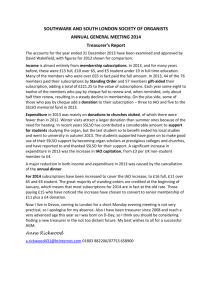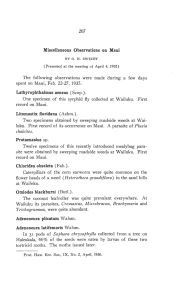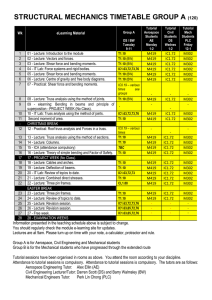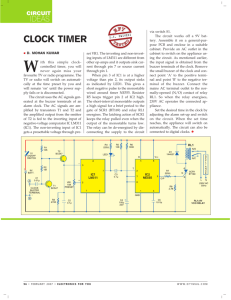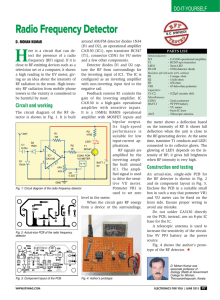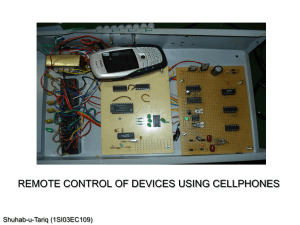Document 10464961
advertisement
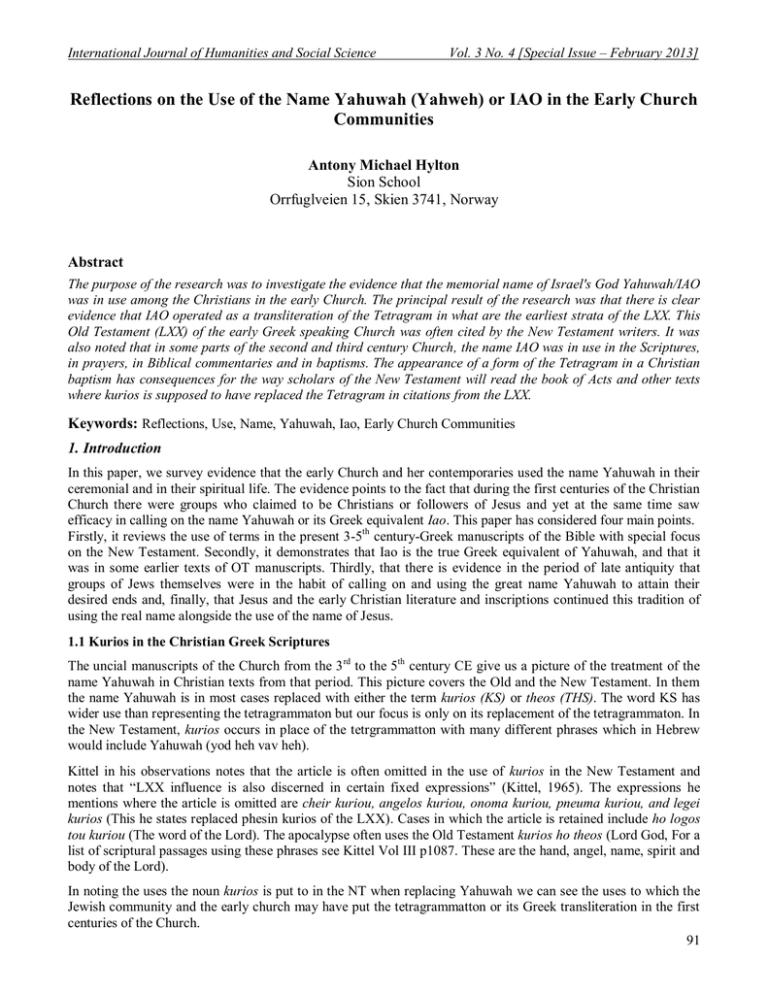
International Journal of Humanities and Social Science Vol. 3 No. 4 [Special Issue – February 2013] Reflections on the Use of the Name Yahuwah (Yahweh) or IAO in the Early Church Communities Antony Michael Hylton Sion School Orrfuglveien 15, Skien 3741, Norway Abstract The purpose of the research was to investigate the evidence that the memorial name of Israel's God Yahuwah/IAO was in use among the Christians in the early Church. The principal result of the research was that there is clear evidence that IAO operated as a transliteration of the Tetragram in what are the earliest strata of the LXX. This Old Testament (LXX) of the early Greek speaking Church was often cited by the New Testament writers. It was also noted that in some parts of the second and third century Church, the name IAO was in use in the Scriptures, in prayers, in Biblical commentaries and in baptisms. The appearance of a form of the Tetragram in a Christian baptism has consequences for the way scholars of the New Testament will read the book of Acts and other texts where kurios is supposed to have replaced the Tetragram in citations from the LXX. Keywords: Reflections, Use, Name, Yahuwah, Iao, Early Church Communities 1. Introduction In this paper, we survey evidence that the early Church and her contemporaries used the name Yahuwah in their ceremonial and in their spiritual life. The evidence points to the fact that during the first centuries of the Christian Church there were groups who claimed to be Christians or followers of Jesus and yet at the same time saw efficacy in calling on the name Yahuwah or its Greek equivalent Iao. This paper has considered four main points. Firstly, it reviews the use of terms in the present 3-5th century-Greek manuscripts of the Bible with special focus on the New Testament. Secondly, it demonstrates that Iao is the true Greek equivalent of Yahuwah, and that it was in some earlier texts of OT manuscripts. Thirdly, that there is evidence in the period of late antiquity that groups of Jews themselves were in the habit of calling on and using the great name Yahuwah to attain their desired ends and, finally, that Jesus and the early Christian literature and inscriptions continued this tradition of using the real name alongside the use of the name of Jesus. 1.1 Kurios in the Christian Greek Scriptures The uncial manuscripts of the Church from the 3 rd to the 5th century CE give us a picture of the treatment of the name Yahuwah in Christian texts from that period. This picture covers the Old and the New Testament. In them the name Yahuwah is in most cases replaced with either the term kurios (KS) or theos (THS). The word KS has wider use than representing the tetragrammaton but our focus is only on its replacement of the tetragrammaton. In the New Testament, kurios occurs in place of the tetrgrammatton with many different phrases which in Hebrew would include Yahuwah (yod heh vav heh). Kittel in his observations notes that the article is often omitted in the use of kurios in the New Testament and notes that “LXX influence is also discerned in certain fixed expressions” (Kittel, 1965). The expressions he mentions where the article is omitted are cheir kuriou, angelos kuriou, onoma kuriou, pneuma kuriou, and legei kurios (This he states replaced phesin kurios of the LXX). Cases in which the article is retained include ho logos tou kuriou (The word of the Lord). The apocalypse often uses the Old Testament kurios ho theos (Lord God, For a list of scriptural passages using these phrases see Kittel Vol III p1087. These are the hand, angel, name, spirit and body of the Lord). In noting the uses the noun kurios is put to in the NT when replacing Yahuwah we can see the uses to which the Jewish community and the early church may have put the tetragrammatton or its Greek transliteration in the first centuries of the Church. 91 The Special Issue on Contemporary Issues in Social Science © Centre for Promoting Ideas, USA Thus, if we were to assume it was not forbidden to use Yahuwah, we would find the name may have been used in greetings (Lk 1:28), in citation of scripture (Mt 3:3; Jn 12:38; Ac 2:34, 3:22, 4:26, 7:49; Rom 10:13, 11:3, 34, 12:19, 14:11, 15:111;1 Cor 1:31, 2:16, 3:20, 10:26, 14:21; Heb 1.10, 7:21. 8:2, 8, 9, 10, 11, 10:16, 30, 12:5, 6 , 13.6; 2 Pet 3:8 ), in spiritual warfare when dealing with the devil (Mt 4.7, 10; Lk 4:8, 12; Ju 9), in teaching (Mt 5:33), in debate between Jesus and his opponents and the confession of the Shema and the reciting of the commandments (Mt 22:37, 43, 44; Mk 12:29; Lk 20:37, 42), in welcoming the Messiah no doubt with singing psalms and shouting (Mt 23:39; Mk 11:9-10; Lk 13:35; Jn 12:13), in testifying to the great acts of Yahuwah on your behalf (Matt 5:19; Lk 1:45; 2:15)2 , in describing those things that have their origin in Yahuwah and that bear his name (Lk 1:6; Lk 1:9; Lk 1:11, 38, 66, 76, 2:9, 2:23, 4:18, 19, 5:17; Ac 2:20, 21, 3:19, 5:9,19, 7:30, 31, 33, 8:25, 26, 39, 9:31, 11:21, 13:10, 11, 12, 48, 49, 21:14; Rom 10:13; Ja 5:7, 8, 10, 11) in identifying Yahuwah God of Israel (Lk 1:15, 2:22, 23, 38; Ac 2:25, 39, 3:22, 7:37, 8:24, 11:32, 13:47, 1 Pet 1:25, 3:15; Ju 4) in prophesying (Lk 1:16, 17, 25, 32, 76) in praising Yahuwah (Lk 1:46, 58, 68; 1 Pet 2:3) in addressing Yahuwah in prayer (Lu 2:29; Ac 4:29, 7:60), baptising in the name of Yahuwah (Acts 10:48[Metzger, 1971] 3; 22:164). These are just the uses in the Gospels and Acts. The Epistles repeat many of these and in addition use the title kurios sabaot or kuriou sabaot (Rom 9:29; Jam 5:4) in anointing the sick for healing (Jam 5:14, 15). When we consider the prevalence of this word kurios in these late manuscripts we come across a very interesting and perhaps perplexing historical problem. In no manuscript of the LXX before the 150AD is the tetragram replaced by kurios. Another very interesting factor in this period is that adon or adonai for which the Greek kurios is a translation is in rarely used as a substitute for the tetragrammaton in the dead sea scrolls. The reason the LXX is important is because the New Testament writers appear to have cited the LXX regularly. Whereas more than 70 years ago. Baudissin could complete his mammoth study (Giessen, 1929) of kurios and conclude that “the ancient LXX read kurios as a surrogate for Yhwh” (Pietersma 1984) more recent evidence has lead to scholars challenging Baudissin's conclusions. All the manuscript evidence from before 150 point to the presence of the tetragrammaton in one of four forms. It appears as a Greek transliteration of the name Yahuwah in the form IAO (iota alpha omega), it appears in paleo hebrew script, Assyrian square script or in Greek letters pipi (pai iota pai iota) which looks similar to the Assyrian square script (Jellicoe, 1969; Conzelman, 1969). With the publication of the first manuscript of this kind Waddell concluded Baudissin was wrong (Wadell, 1944). Howard's (1977) study of the tetragram in the NT takes into account this new evidence. 5 On the basis of this evidence and his analysis he arrives at a very interesting and important conclusion: From these findings we can now say with almost absolute certainty that the divine name..., was not rendered by kurios in the pre- Christian Bible, as so often has been thought. Usually the Tetragram was written out in Aramaic or in paleo-Hebrew or was transliterated into Greek letters (Howard, 1977). From this conclusion Howard (ibid.) deduces quite reasonably that the NT writers, when citing the LXX or the Greek OT with the tetragrammatton, would have naturally included the tetragramm in their citations. For him this would have maintained the distinction which he feels should have been maintained between the Lord God and the Lord Christ. His conclusions however have more recently come under challenge by Piertersma (1984). Having argued that there are four main sources of evidence that point to the priority of the tetragrammaton in the LXX Pietersma tries to show that 1 From Psalm 117:1 Hallelu et Yahuwah, aineite panta ta ethne ton kurion This idea of foreigner going back to his people and testifying what great things Yahuwah had done for him may be a reflection on the gospel writers seeing Jesus fulfilling one purpose in Solomons prayer at the dedication of the temple, see 2 Chron 6:32) 3 Metzger in A textual commentary on the Greek New Testament (stuttgart: ubs, 1971) notes “ It may be argued that the primitive reading was tou kuriou, which was expanded or supplanted ...in order to denote more precisely the specific character of the baptism”. P 383 4 Again some manuscripts read his name not the to onoma to kuriou 5 It is actually not so new because Origen argues for this position back in the 3 rd century, however this brings us no closer to the form of the tetrgram or a surrogate in the first rescensions of the LXX which were written all 500 years beofre Origens time. However it is important evidence for the state of some Greek texts at the time of Origen. 2 92 International Journal of Humanities and Social Science Vol. 3 No. 4 [Special Issue – February 2013] Of the four early texts that have been cited in support of an original tetragram, one gives no evidence at all, a second is non Septuagintal, and a third contains hebraizing revisions (including at least one instance of the tetragram. Only one text, 4QLXXLevb, would seem to have good credentials as a typical exemplar of the LXX (ibid., p. 92). The four texts Pietersma refers to are P.Fouad 266 (Rahlfs 848), P. Ryl. Gk 458 (Rahlfs 957), 8 HevXIIgr (Rahlfs 943) and 4QLXXLevb. Of these four, the only one which contains IAO as a transliteration of Yahuwah is 4QlxxLevb. This paper is presented as one answer to the criticism of Piertesma (ibi.d). If then the NT writers were to have come across IAO in their texts it would be that name which they would naturally have incorprated into their citations from the LXX or other texts using that form of the name Iao. Our purpose in this paper is to look at other evidence which would support the idea that the early church not only had IAO in the scriptures they read but included it in their prayers and even in their baptismal confessions. 1.2 The Memorial Name in Greek Texts According to the Letter to Aristeas the translation of the first five books of Moses began in the reign of Ptolelmy II Philadelphus (285-246 B.C.) in the city of Alexandria in Egypt. Although the idea that there were 70 translators is deemed legendary, the name Septuagint or LXX has been retained. Thus began what may be the memorial Yahuwah’s first major encounter with the Greek script and Greek beliefs and practices. The writings which demonstrate the use of the name in this language range from 285 B.C. with first translation of the Torah into Greek to after 1000 A.D. with Greek magical texts which reflect earlier Greek practices in the treatment of the name. Thus we are dealing initially with the foundational writings of Hellenistic Judaism. Our texts, then, begin with early fragments of the so called LXX and recensions and developments which sprung from that and dealing with what is called the “Old Greek”. We also have the witness of Diodoros of Sicily, Philo, the Apocrypha, the Pseudipigrapha, the New Testament, and Josephus. In addition, we have the translations of Aquila, Symmachus, and other Greek translations. We also have the “Christian” Gnostic writings and those of the “Orthodox” Church of the second to tenth century, the Apostolic Fathers, the Apologists particularly Irenaeus, Tertullian, Clement of Alexandria, Origen, Eusebius, Epiphanius, Theodoret and Jerome. In addition we have the Greek “magical” papyri stretching from the second to the eleventh century A.D. 2. Main Discussion 2.1 That Iao is Yahuwah The first piece of evidence we will consider that indicates that Iao (iota, alpha, omicron or omega) is in many cases the Greek transliteration of Yahuwah comes from a scroll of the Judean desert. 4QLXXpapLevb (Skehan, 1957; Parsons, 1992) renders the name Yahuwah with the letters iota alph omega (IAO). It does this in two passages, namely Leviticus 3:12 and 4:27. This is done in the context of a scripture leaving no doubt that Iao here is the equivalent of the memorial name. The pronunciation of the final heh apparently left silent. The script used is uncial and the script of the name is the same as the script of the rest of the text, there is nothing there to indicate that the name should be treated in any way different to the rest of the text when it would come to reading it. De Troyer (2005) observes “In this Old Greek Text of the Book of Leviticus the name of God is written Skehan, the editor of the text, suggests that the reading IAW is more original thanurios: k “This new evidence strongly suggests that the usage in question goes back for some books at least to the beginning of the Septuagint rendering” (De Troyer, 2005). She also observes the importance of the fact that the name is written simply and with no modification. This indicates no special treatment was assigned to the name in a period when some expect the name to be treated as too holy to be read. This evidence is contrary to that and indicates the name was read as other words in scripture were read. De Troyer (ibid.) notes “The appearance of IAO in the Leviticus scroll has left many scholars baffled. Is it proof that the Tetragrammaton was still pronounced in the first century BCE?” (ibid.). A partial answer to that telling question may be indicated by our second source of evidence that Iao is Yahuwah in the Greek script. Here we turn to the testimony of a pagan from the first century B.C., Diodorus of Sicily (6030 B. C.). Diodorus had some connection with the Jews and testified to their usage of the name IAW saying “Amongst the Jews Moses pretended that the god surnamed Iao gave him his laws” (Diodorus, 49B.C.; King, 1887, p. 319). 93 The Special Issue on Contemporary Issues in Social Science © Centre for Promoting Ideas, USA There is then some evidence that seems to indicate the name Yahuwah was present in the earliest Greek translations of the scriptures as opposed to the later and secondary kurios. It was present in the form IAO. This is the conclusion of Skehan (1957) and De Troyer (ibid.). We can go further than this, there is also evidence that seems to indicate that Christians of the second and third century contained the name Iao in the scriptures in use in their circles. This evidence is secondary but nevertheless clear. Our first source of this evidence is Tertullian who relates the Valentinian explanation as to the reason the name came to be in the Scriptures. It is related the story of the Gnostic Sophia meeting Horus in the Valentinian myth Tertullian (ANF 03 Latin Christianity its Founder Tertullian). Try, however, she did, and perhaps would have found Him, had not the self-same Horos, who had met her mother so opportunely, fallen in with the daughter quite as unseasonably, so as to exclaim at her IAO! just as we hear the cry “Porro Quirites” (“Out of the way, Romans!”), or else Fidem Cæsaris!” (“By the faith of Cæsar!”), whence (as they will have it) the name IAO comes to be found is the Scriptures (ibid., p. 511). We see that Tertullian (160-225) does not dispute the fact that the name Iao is in the scriptures but relates the story as to why the Valentinians believe the name is present in the scriptures. This is very important evidence that the scriptures of Christians both “orthodox” and “heterodox” contained the name Iao in the second and third century. Considering that there is no textual evidence indicating Christians had the name Iao in their scriptures, this evidence has more importance attached to it. If Tertullian did not have IAO in his scriptures he would of course not have paid attention to this story of the Valentinians, but he was clearly aware of the presence of the name in the Scriptures and is relating their tradition as to how it got there. Origen (185-254) is in agreement with Tertullian and the Valentians regarding the presence of IAO in the scripture. In his Against Celsus (185-254) chapter 32 Origen (185-254) discusses the schemes of sorcerers. He makes the point that they mix names in their magic using names from the Scripture and names from magic. It must be noticed, too, that those who have drawn up this array of fictions, have, from neither understanding magic, nor discriminating the holy scripture, thrown everything into confusion; seeing they have borrowed from magic the name Ialdaboth, and Astaphaeus, and Horaeus, and from the Hebrew Scriptures him who is termed Iao or Jah, and Sabaoth, and Adonaeus, and Eloaeus. Now the names taken from the Scriptures are names of the one and the same God; which not being understood by the enemies of God, as even themselves acknowledge, led to their imagining Iao was a different God, and Sabaoth another, and Adonaeus whom the Scriptures term adonai, a third besides, and that Eloaeus, whom the prophets name in Hebrew Eloi, was also different (ANF04). Origen’s understanding shows that IAO was seen as a direct transliteration of Yahuwah, for he may be read as contrasting Iao with Jah. Another piece of evidence deriving from Origen that he as a member of the second and third century Church; read Iao in the scripture and taught on it is shown in his Commentary on the Gospel of John. There he connects the name with the ministry of Jeremiah. He explains that Jeremiah was lifted up by divine elation and the Word came to him. “For Iao means etymologically lifting up, elation” (Schaff, 1819-1863). Tertullian (160-225) and Irenaeus (120-202) both explain the origin and the function of Iao in the Valentinian systems. Of all the Gnostics groups the Valentians were some of the closest to “orthodoxy”. According to some sources Valentinus was a respected teacher in the Catholic Church in Rome sometime in the middle of the second century. Ireneaus was asked to expose the Valentians because their beliefs were not so publicly heretical. So Pagels (1979) states “the majority of Christians did not recognize the followers of Valentinus as heretics. Most could not tell the difference between Valentinian and orthodox teaching” (Pagels, 1979, p. 32) Ireneaus was trying to smoke out the Valentinians because they were not so obviously different. Valentinus claimed to be a disciple of Theodosias who was a disciple of the Apostle Paul to all intents and purposes to outsiders and even to many insiders the Valentinians during the mid second century were “Christians”. In their tradition the word Iao was first spoken rather as an exclamation. For Tertullian this was the Valentinian explanation as to how the word came to be in the Scripture, but for Irenaeus it represented the origin of the word (Irenaeus, ibid). Having seen that the name IAO was present not only in pre Christians texts of the Pentatuech and in the Scriptures of the Valentinians and Tertullian, we would naturally expect the name to make its appearance in early Christian liturgy, prayers and teaching. 94 International Journal of Humanities and Social Science Vol. 3 No. 4 [Special Issue – February 2013] 2.2 Christian Gnostic Ascension Confession to Iao Some Gnostics explain that Iao was son of Ialdabot and from Iao derived Sabaoth and four other aeons afterwards. Iao and Sabaoth are both scriptural terms which correspond with the New Testament kuriou sabaoth. Origen in BookVI and Chapter XXXI of Against Celsus explains that when a sorcerer descended or ascended through the aeons he had certain declarations to make in each realm. He would reach the realm of Iao having left the realm of Ialdalbot (In some systems of Gnosticism Iao was the son of Ialdaboth). On travelling through the realm he was to say to Iao Thou, O Second Iao, who shinest by night, who art the ruler of the secret mysteries of son and father, first prince of death. And portion of the innocent, bearing down now mine own beard as symbol, I am ready to pass through thy realm, having strengthened him who is born of thee by the living God. Grace be with me; father let it be with me (ANF04., p. 588)6. Here Iao seems to be identified with the moon. Gnostics had many ascensions where they went through the realms of different aeons. Iao was percieved as one of these aeons. Although Origen identifies the speakers as sorcerers the term Iao, Sabaoth, Father, Son and living God and “grace be with me” all point to Christian or Biblical influences 7. 2.3 Christian Gnostic Baptismal Confession Perhaps the most striking text is that of a baptismal confession containing Iao. In Book I chapter XXI of Irenaeus (180)8 Against Heresies he begins to talk about the views of redemption held by various groups. He covers a number of schemes of redemption where the groups practice different baptisms. He describes how one group sees the baptism initiated by Jesus as that for the remission of sins, but the redemption by the Christ who descended on Jesus as baptism for perfection. Others perceive the baptism as a spiritual marriage and they perform mystic rites based around them. He then describes how some groups use Hebrew words and he gives transliteration of certain words. Finally he comes to a baptismal ceremony which involves a declaration by the initiator and a response by the initiate: Initiator: I do not divide the Spirit of Christ. Neither the heart nor the supercelestial power which is merciful, may I enjoy thy name, O saviour of truth! Initiate: I am established, and I am redeemed. I redeem my soul from this age (world), and from all things connected with it in the name of Iao 9, who redeemed his own soul into the redemption of Christ who liveth (ANF01). Another translation reads I am strengthened and redeemed, and I redeem my soul from this age, and from all things connected with it in the name of Iao, who redeemed his soul to full redemption in the living Christ10. Ireneus (ibid.) believes these words were initially spoken in Hebrew and he gives an interpretation. The only significant point for our purposes is the fact that this baptismal formula includes a form of the tetragrammaton. Here the establishing, redeeming and redeeming of the soul from the world is all declared by the initiate in the name of Iao or in Hebrew terms it would have been in the name of Yahuwah, thus picking up on the formulaic beshem Yahuwah so prevalent in the Old Testament 11. 6 www.ccel.org/ccel/schaff/anf04.vi.ix.vi.html. Interestingly in Book I Chapter LXXI of this same book Celsus is said to accuse Jesus of being a sorcerer. Much of made of this idea in the study of Morten Smith Jesus the Magician (Harper and Row: 1978) 8 http://en.wikipedia.org/wiki/On_the_Detection_and_Overthrow_of_the_So-Called_Gnosis (06/12/2012) It is dated to about 180 because it mentions the Bishop of Rome. See Schaff, Philip (2001) [c. 1885] "Introductory Note to Irenæus Against Heresies", Ante-Nicene Fathers, Volume I, Against Heresies, William B. Eerdmans Publishing Company. 9 In Hebrew this would read beshem Yahuwah that popular phrse from the scriptures. Jews also baptised in the name of God and even Toseftah Yad 2:20 points to a connection between the name and immersion. 10 www.ccel.org/richardson/fathers.xi.i.iii.html?highlight=iao 11 Gen 4.26; Gen 12:8; Psalm 118:10-12. 7 95 The Special Issue on Contemporary Issues in Social Science © Centre for Promoting Ideas, USA To find a form of Yahuwah’s name in a baptismal confession should not be too surprising; for we find in the NT a clear connection between calling on the name Yahuwah (kurios in our texts) and baptism. Acts 2:21 says. “Everyone who calls on the name of the Lord” 12 (kurios, Iao) will be saved. Later on they are urged to “save themselves from the corrupt generation and told to be baptised (Acts 2:38-41)13. This baptismal evidence also supports the idea that Iao was a name present in the scripture which then became a part of liturgy. This brings us to the final area we will observe today Iao in the prayers of the early Church. Are there texts which indicate that Iao as a transliteration of the tetragrammaton entered into the private spiritual life of individual Christians? For these we examine the works of Meyer and Smith (1999), Ancient Christian Magic Coptics Texts of Ritual Power. In these selections we find scriptures, charms, spells, prayers and confessions. The important point for our paper is that they show the combined use of the name Iao (Yao in the translations) with the name of Jesus. Thus we find in text 36: MS36 Grant me victories , favour, good luck with N., success with people small and great, whom I may encounter today, during all the hours of the day and the night. For I have before me Jesus Christ , who attends me and accompanies me; behind me Yao Sabaoth Ado[nai]; on my right and [left] the God of Ab[raham, Isaac, and Jacob]; over [my] face... my heart... s can be seen the writer prays for success. He confesses that in front of him is Jesus Christ and behind him Iao Sabaoth. It is a papyrus and dated to around 300CE not so distant from the time of Tertullian with the scriptures containing Iao. 3. Conclusion We see then that Iao is present among Christians both Gnostic and “orthodox”. It is also present in those termed sorcerers. It is clear from our short survey that the term Iao was not only present in pre Christian texts but also in second century Christian texts. What then should be our conclusion? We observed at the start the amazing prevalence of kurios in the later NT manuscripts both in citations from the LXX where tetragram was present in Hebrew. We discovered that this term kurios is conspicuous by its absence in the early years of the Church up until 150 AD. The form of the name which seems to have been present both in pre Christian times and in the times of the Church is IAO although we have no manuscript evidence from the first century we have a lot of secondary evidence from Origen, Tertullian and Ireneus. Although our paper is short it seems clear from the evidence that Iao has been in use in the early church much more than perhaps we would have suspected. 12 A citation from Joel 2:32 which uses the phrase beshem yahuwah A connection between immersion and calling on the name Yahuwah is also seen in the Jewish tradition. We can see in the Toseftah tractate Yadayim 21 13 96 International Journal of Humanities and Social Science Vol. 3 No. 4 [Special Issue – February 2013] References Conzelman, H. (1969). An Outline of the Theology of the New Testament. New York, pp. 83-84. De Troyer, K., (2005). The Names of God – lectio difficilior. Retrieved from http//www.lectio.unibe.ch Giessen, (1929). Kyrios als Gottesname im Judentum und seine Stelle in der Religionsgeschichte 4 vols. Howard, G. (1977). The Tetragram and the New Testament. JBL, 96 Ireneus, Against Heresies Retrieved from www.ccel.ord/ccel/schaff/anf04.vi.ix.vi.xxxii.html Jellicoe, S. (1968). The Septuagint and Modern Study (Oxford) pp. 271-72 King, C. W. (1887). The Gnostics and their Remains. Retrieved from http://www.sacredtexts.com/gno/gar/gar45.htm Kittel, G. (1965). Theological Dictionary of the New Testament. Geoffrey Bromiley (Ed. Trans.). Michigan: Grand Rapids. Metzger. B. (1971). In A Textual Commentary on the Greek New Testament. (Stuttgart: ubs) Meyer, M., & Smith, R. (1999). Ancient Christian Magic Coptics Texts of Ritual Power. 1994 Coptic Magical Texts Projects of the Institute for Antiquity and Christianity. Mowinckel, S. (1961). The Name of the God of Moses. Hebrew Union College Annual, XXXII: 121-133. Pagels, E. (1979). The Gnostic Gospels. New York: Random House. Parsons, P. J. (1992). Qumran Cave 4. IV. Paleo-Hebrew and Greek Biblical Manuscripts. Discoveries of the Judaean Desert, IX, Oxford: Clarendon Press, p. 174 Piertesm, A. (1984). DE SEPTUAGINTA. In A. Pietersma, & C. Cox, (Ed.). Studies in Honour of John William Wevers on his sixty-fifth birthday (pp. 85-101). Mississauga: Benben Publications. Schaff, P. (Ed.). (1819-1863). ANF01. The Apostolic Fathers with Justin Martyr and Irenaeus. Grand Rapids Michigan: W.M. Eerdmans Publishing Company. Schaff, P. (Ed.). (1819-1863). Ante Nicene Father Vol 3: Latin Christianity: Its founder, Tertullian, I Apologetic, II Anti Marcion, III, Ethical. Grand Rapids Michigan: W.M. Eerdmans Publishing Company. Schaff, P. (Ed.). (1819-1863). ANF04. Fathers of the Third Century: Tertullian, Part Fourth; Minucius Felix; Commodian; Origen, Parts First and Second. Grand Rapids Michigan: W.M. Eerdmans Publishing Company. Schaff, P. (Ed.) (1819-1863). ANF09. The Gospel of Peter, The Diatessaron of Tatian, The Apocalypse of Peter, the Vision of Paul, The Apocalypse of the Virgin and Sedrach, The Testament of Abraham, The Acts of Xanthippe and Polyxena, The Narrative of Zosimus, The Apology of Aristides, The Epistles of Clement (complete text), Origen’s Commentary on John, Books 1–10, and Commentary on Matthew, Books 1, 2, and 10–14. Grand Rapids Michigan: W.M. Eerdmans Publishing Company. Skehan, O. (1957). The Qumran Manuscripts and Textual Criticism, XXX. Vetus Testamentum Supplement, 4, Leiden: Brill. Waddell, (1944). The Tetragrammaton in the LXX. JTS, 45: 158-61. 97
